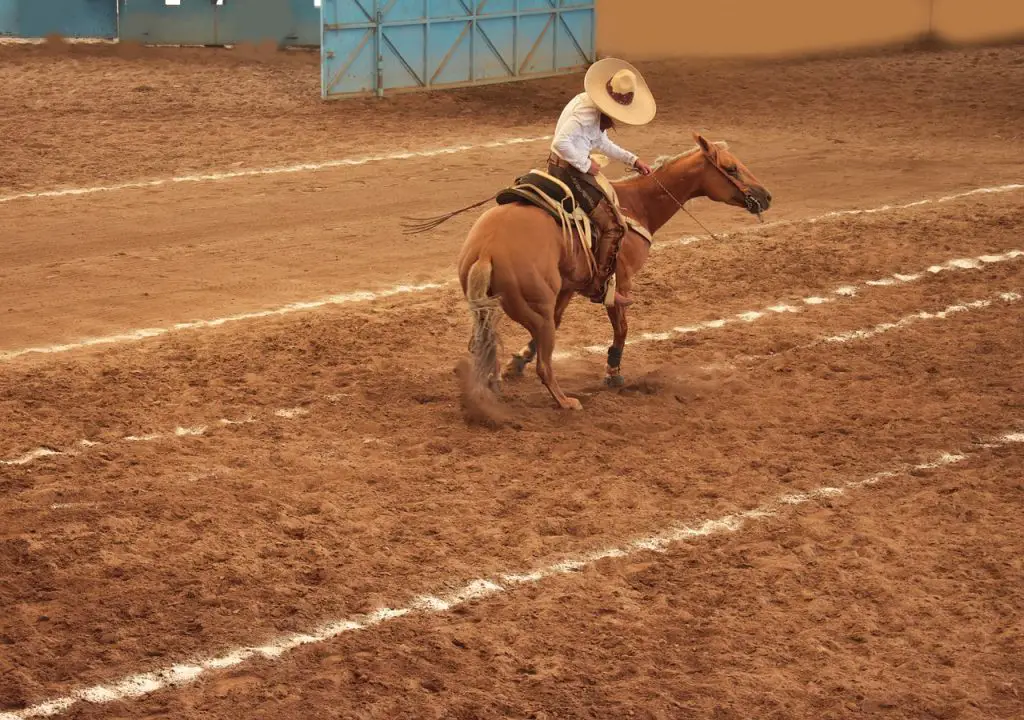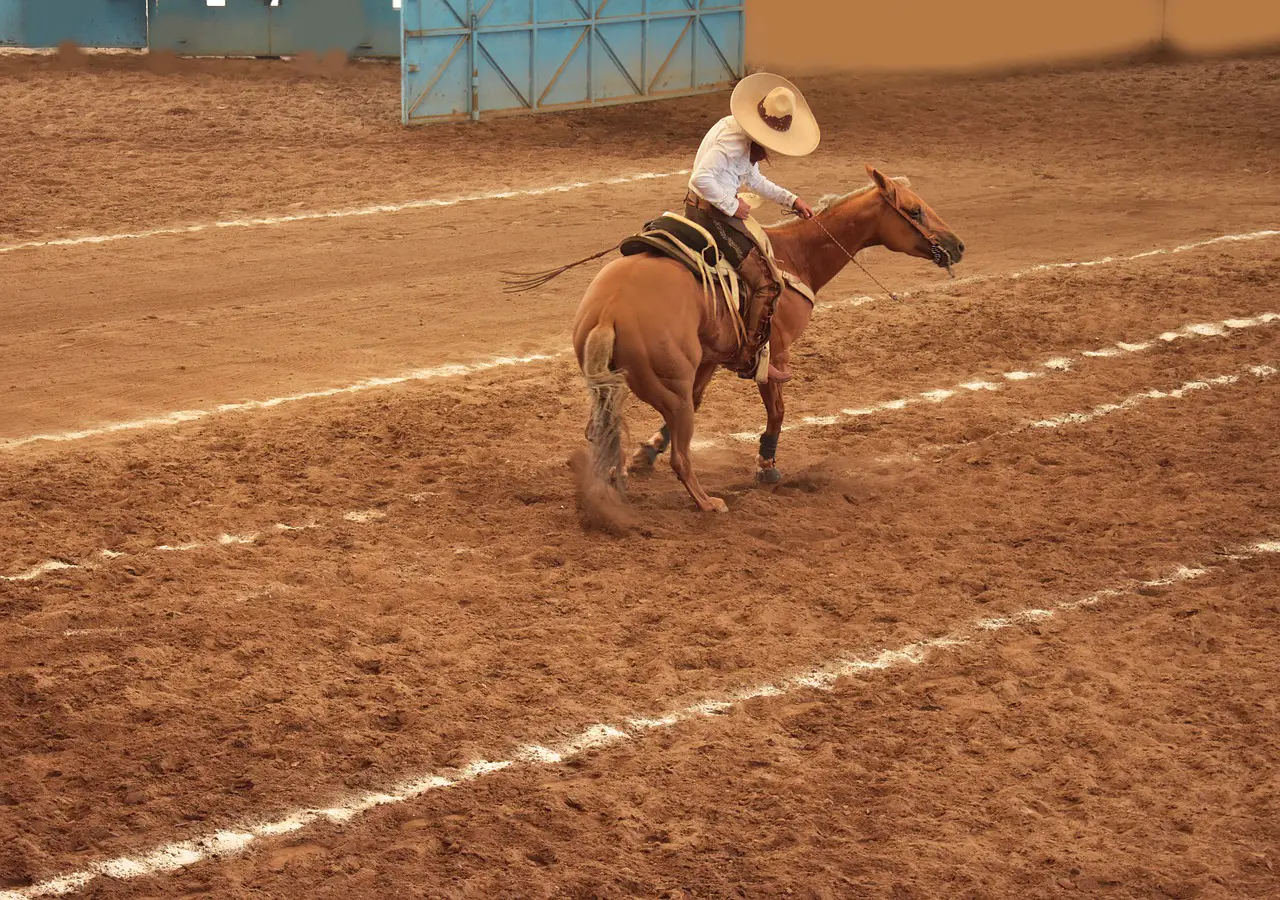Last Updated on March 1, 2022 by Allison Price
Cutting is one of many horse competitions. This type of competition sees a rider use a cutting horse to “hold” a cow from a herd. It is a true battle between wills. But the question is, “What is a cutting horses?”
Are they a particular breed? Or are there horses that have been trained specifically for competition purposes? Continue reading to learn more.
Table of Contents [ hide]
- What is a Cutting Horse?
- Cutting Horse and Race Quarter Horse: What’s the Difference?
- What Horses are Used for Cutting?
- What is a Cutting Horse Worth?
- How long does it take to train a cutting horse?
- What Does it Cost to Train a Cutting Horse in the United States?
- Cutting Horse Myths to Debunk
- Summary
What is a Cutting Horse?
A cutting horse, also known as a stock horse, is a horse that can work with livestock. It was bred and trained to cut, which requires horse and rider, to remove a cow from her herd and keep it separate for a set period.
The horse must be able to read the cows and anticipate their attempts to return to the herd.
What is the Difference Between Cutting Horse and Race Quarter Horse?
American Quarter is a horse variety that is well-known for its racing ability. This breed’s name is based on their ability to run faster than other horses and perform well over shorter distances.
This breed has been around since the 17th century. It is still very popular today. Quarters are so beloved that the American Quarter Horse Association is the largest breed registry worldwide.

They are able to work on ranches and compete in rodeo competitions, thanks to their extraordinary race ability. Quarter horses can also be used in English horseracing disciplines such as jumping, driving, show, dressing and hunting.
Different breeders have focused on different traits because of the versatility of this breed. There were minor differences in the Quarter horses that were used for racing and those for cutting. However, they share many similarities in appearance and temperament.
Quarter Horses of the Hunter and Racing Type
These horses are bred for speed and have long legs. They are also muscular and lean. This stance is often similar to that of Thoroughbred horses which are used in English equestrian disciplines. They can reach 17 hands in height.
Cutting (Stock) Quarter Horses
Although they are smaller in stature than most horses, cutting horses are well-suited to work with livestock. They can run in random patterns and still achieve high speeds while running shorter distances. Their powerful hindquarters enable them to reach great speeds.
Most cutting horses are between 14-16 hands tall and have a muscular appearance. The head is small and elegant, and has a straight profile. It rests on a muscular neck. The muscular body features strong, round hindquarters with a large chest and broad shoulders.
All coat colors can be accepted, but sorrel is the most popular. It’s a brownish-red that looks similar to chestnut. Other popular colors include palomino and chestnut, bay, black, palomino and grey, as well as perlino and cremello.
What Horse Types are Used for Cutting?
The majority of cutting horses are American Quarter horses. The competition allows for the use of horses with American Quarter ancestry such as American Paint horses. You can also use other breeds of stock horse, but only in specific competitions.https://67643c42705e4722bf22d4577c26b9ba.safeframe.googlesyndication.com/safeframe/1-0-38/html/container.html
What is the Value of a Cutting Horse?
The value of a cutting horse depends on its age and the training it has received. An American Quarter filly or colt with promising traits and good lineage can be purchased for between $2,500 to $10,000.
Elite horses with a strong competition record can be more expensive. For such a horse, you can expect to spend around $25,000 You can also find stallions for as much as $100,000.
These costs are not the only ones. Maintenance and training costs can add up to $1,000 per pet for boarding or vet.
How long does it take to train a cutting horse?
There are many factors that will affect the time it takes to train a horse for cutting. First, consider whether the horse has ever been trained. It’s often easier to work on horses that aren’t trained, especially if they were not previously trained for cutting.
This is because horses who have been partially trained may have bad habits and need to be rehabilitated before they can go on to cutting training.
The horse’s natural ability manage cattle is another factor. It usually takes between four and five months to train for show before you can start cutting. It might take 12-18 months to get the horse ready for competition.
The horse will require at least six to eight month of show experience in order to become solid and reach its full potential. This means that you can expect to spend about three years training.
What is the cost to train a cutting horse?
Training costs can be as high as $1,000 per month, with $75 an hour for any additional lessons.
Debunking Horse Myths
Although it is costly to own a cutting horse, your efforts and investment could be worthwhile if you train a champion. The National Cutting Horse Association awards a $250,000 money prize to the Open champion, and a total amount of $1.8 million in money prizes.
But just because you own a stock American Quarter does not mean you will win all the cash. These myths are worth dispelling.
1. My Horse’s Bloodline is Impeccable, Therefore My Horse Is A Champion
Your horse is not a champion, but it can become one if you put in the effort to train and maintain it. It is also important to check the impeccable bloodlines. How old were your parents and grandparents?
Did they cut horses or race quarters? Did they have any ranch horses that were not performing well? Your colt doesn’t have to be purebred to win a cutting contest.
2. It’s enough to train my horse for six months if the trainer is good
Even if you have the best trainer, your colt won’t be ready for competition in six months. If the horse is naturally able to control cattle, it takes at most 12 months to prepare a colt for future success. You can expect at most 18 months of training.
3. I just bought a Trained Cutting Horse and I am going to take it to a show next week. It should do pretty well
Another misconception is that you can bring a newly purchased cutting horse to a competition and expect a good performance. Although cutting horses can be trained to work independently, it is also true that the performance of the rider has an impact on the horse’s ability.
Inexperienced riders can make the horse fall if they are not careful. It is important to practice with your horse before entering a competition.
4. My horse loves to chase animals around, so he’s a great cutter
Do you have a colt who loves to chase other horses or animals? He might not be a good cutter, but it does not mean that he isn’t a great horseman. Horses may only be playful – many stock horses enjoy following other animals and people. This doesn’t necessarily mean that they won’t do well in a competition.
Keep in mind that the colt is free to chase other animals in the pasture without the assistance of a rider and does not have to follow any rules or form. Ask a trainer or coach if the colt would be a good cutter.
5. My Horse is comfortable working with cattle, so he’d make a great cutter.
It is not our intention to ruin your experience, but stock horses were bred to be comfortable with livestock. Your horse’s ability to tolerate a herd of cattle is not a sign that he will be a good cutter. Trainers and coaches say that your horse might not react to a herd.
Most great cutting horses have strong reactions to cattle, either fear or aggression. With the proper training, both reactions can be corrected. However, a horse who doesn’t show interest in cattle will likely make a poor ranch horse.
Summary
If your filly or colt becomes a champion, cutting competitions can be fun. You will need to put in a lot of effort and time. You will be rewarded for your efforts with horses.


